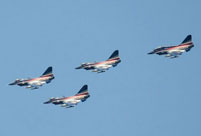Since August China's fourth-generation stealth fighter, the J-31 "Falcon Hawk", has carried out more than three sets of trial flights at a rapidly increasing frequency. America's fourth-generation equivalent has achieved huge market penetration, and analysts believe that the excellent performance of the J-31 will make it a strong competitor in this market.
J-31 performance compares favorably with F-35
Although similar to the fourth-generation stealth fighter, the J-31's overall aerodynamic design and stealth appearance is not so identical with J-20, which has a higher degree of exposure. Military enthusiasts prefer to compare the relation of J-31 and J-20 with that of the U.S. Air Force F-22 and F-35. J-31 and F-35 use the same DSI inlet (non-boundary layer separated lane supersonic inlet) design, the difference is, F-35 uses a single engine to provide power, but J-31 is designed with double engines. In addition, some models of F-35 support the short distance/vertical landing; J-31 cannot do this for the time being.
Earlier reports indicate that the J-31 is equipped with twin Russian RD-93 engines - news that has been confirmed by Russia's MiG Aircraft Corporation. The "Fierce Dragon" light fighter developed jointly by China and Pakistan is also equipped with this model of engine. Judged against the specifications of fourth-generation aircraft, the RD-93 engine seems somewhat old, but during prototype testing the use of a stable engine with mature technology is the safest approach. Sources point out that once in service, the J-31 will hopefully carry our self-developed WS-13 engine, which has significantly improved performance in comparison with the RD-93.
China's Air Force test pilot expert Xu Yongling points out that the J-31's stealth aerodynamic design, stealth engine design and stealth coating design have all reached internationally advanced standards in stealth technology. He also pointed out that the J-31 possesses both stealth capability and a considerable payload level. In addition, Xu Yongling says that China has its own considerations in the development of fourth-generation aircraft, taking account not only of the need for stealth, but also of its performance in air-to-ground and air-to-air combat, and the relevant weapons requirements. This means that in payload, the J-31 will prevail over the F-35.
Domestic fourth-generation aircraft target the export market
A landmark in international military aviation history, the fourth-generation stealth aircraft will not only have a great impact on combat strategy, but also exercise a tremendous influence on geopolitics, especially on international relations and the geo-strategic situation in the Asia-Pacific region. The stealth fighter has gone beyond a simple weapons platform; its presence is now an indication of the balances and the strategic considerations at play among different countries. It could be said that the high-tech weapon systems represented by stealth fighters are becoming a new variable in the Sino-US strategic game.
Experts predict that the J-31 will make rapid inroads in the international market in the future, and will undoubtedly steal the limelight from the F-35. China's fourth-generation aircraft will become a new option for those countries which have not yet made the decision to purchase the F-35. In particular for those countries which are excluded from access to U.S. arms exports, China's fourth generation aircraft will certainly be attractive. The J-31, with its main target as the export market, represents a serious threat to U.S. arms manufacturers.
Link:
J-31 can be part of an aircraft carrier's payload.
Earlier this year, the chief architect of the J-31 fighter Sun Cong revealed that the improved version of the J-31 is expected to become China's next generation of carrier-based aircraft.
Analysts believe that the J-31 fighter can act as a carrier-borne aircraft. One of the important factors affecting this question is the configuration of the landing gear. The front landing gear of the J-31 is designed with double wheels (the J-20, which is twice the weight, only has single front wheel), while the back landing gear adopts a dogleg structure – both these features provide strong supporting capacity and excellent shock resistance. Considering that a carrier-borne aircraft requires the ability to withstand a greater impact when landing on an aircraft carrier than when landing on land, the J-31 seems designed to meet the requirements of a carrier-borne landing.
In addition, it has recently been reported that if the J-31 is deployed on the aircraft carrier, it may combine in light-weight battle formations with the early-service J-15.
 Weekly selection of world photos (Aug.19-Aug.24)
Weekly selection of world photos (Aug.19-Aug.24) Preview of Moscow air show
Preview of Moscow air show Top 10 Chinese provinces for the well-heeled
Top 10 Chinese provinces for the well-heeled  Fan Bingbing poses for Malaysian magazine Citta Bella
Fan Bingbing poses for Malaysian magazine Citta Bella Wild dream: Hell-like training for bodyguard
Wild dream: Hell-like training for bodyguard  Zhang Xinyi covers COSMOPOLITAN
Zhang Xinyi covers COSMOPOLITAN The story of a savior sibling
The story of a savior sibling China’s weekly story
China’s weekly story  A collection of bizarre rooftop buildings around China
A collection of bizarre rooftop buildings around China 100th birthday of 'Little Mermaid'
100th birthday of 'Little Mermaid' Escort taskforce holds live-fire training
Escort taskforce holds live-fire training Adorable! Marmots get along well with herdsmen
Adorable! Marmots get along well with herdsmen 2013 Taiwan Int'l Tourism Expo kicks off in Taipei
2013 Taiwan Int'l Tourism Expo kicks off in Taipei Photo story: Take a gap year
Photo story: Take a gap year Nokia's Global Headquarters: visiting a declining empire
Nokia's Global Headquarters: visiting a declining empireDay|Week|Month